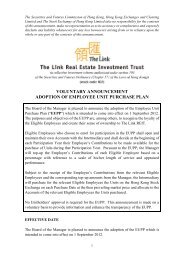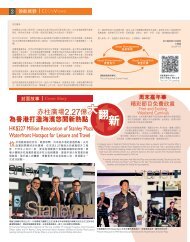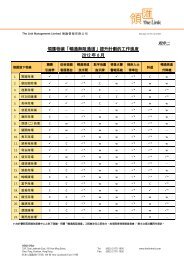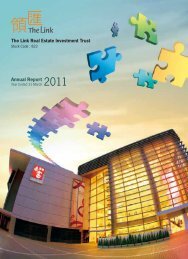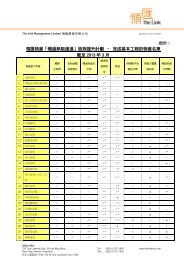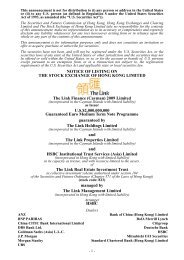You also want an ePaper? Increase the reach of your titles
YUMPU automatically turns print PDFs into web optimized ePapers that Google loves.
<strong>Annual</strong> <strong>Report</strong> <strong>2007</strong><br />
<strong>The</strong> <strong>Link</strong> Real Estate Investment Trust<br />
141<br />
Valuation <strong>Report</strong><br />
comparison approach, this method of valuation has inherent limitations in quantitatively reflecting various property specific<br />
characteristics including:<br />
• Quality of existing tenant covenants;<br />
• Lease expiry profile;<br />
• Vacancy rate and leasing potential;<br />
• Passing rents in comparison to market;<br />
• Redevelopment potential;<br />
• Potential for turnover and rental growth.<br />
All of these factors are particularly important to <strong>REIT</strong> vehicles as they directly impact on the cashflow and growth potential<br />
associated with the property (and hence the return to investors in the <strong>REIT</strong>). In relation to the direct comparison approach,<br />
these dynamic factors must all be reflected in a single variable, namely the value rate per square metre.<br />
In contrast, both discounted cash flow analysis and the capitalisation approach can accurately reflect these property<br />
specific items by utilising individual assumptions which have been verified by market evidence. <strong>The</strong> ability to adopt specific<br />
assumptions to reflect the tenancy and cash flow profile in both these valuation methods is considered to be particularly<br />
relevant for <strong>REIT</strong> based purchasers where delivering returns to investors is of paramount importance.<br />
<strong>The</strong> discounted cashflow methodology utilises a Target IRR to determine an assessment over a 10 year investment horizon,<br />
and the capitalisation approach is based on the net income profile of the property. Our adopted value falls within the range of<br />
these two assessments and reflects an indicated IRR.<br />
A brief summary of each of these valuation methods is provided in the following pages.<br />
Discounted Cash Flow Analysis<br />
We have carried out a discounted cashflow analysis over a 10-year investment horizon in which we have assumed that the<br />
Property is sold at the commencement of the eleventh year of the cashflow. This form of analysis allows an investor or owner<br />
to make an assessment of the long term return that is likely to be derived from a property with a combination of both rental<br />
and capital growth over an assumed investment horizon. In undertaking this analysis, a wide range of assumptions are made<br />
including a target or pre-selected internal rate of return, rental growth, sale price of the property at the end of the investment<br />
horizon, costs associated with the initial purchase of the property and also its disposal at the end of the investment period.<br />
<strong>The</strong> cashflow analysis, which comprises annual income streams, is based upon the following assumptions:<br />
• We have estimated that inflation will grow at rates between 2.50% and 3.10% per annum during next 10 years, reflecting<br />
an average growth rate over the forecast cashflow period of 2.72% per annum.<br />
• Rental growth patterns for each individual tenancies and carpark operations reflect the rent review provisions of each<br />
lease, including staggered rental increase where applicable. We have assumed that upon expiry of the tenancies and<br />
carpark operations, typically new three-year leases will be granted on the basis of a market rent with no annual increases.




